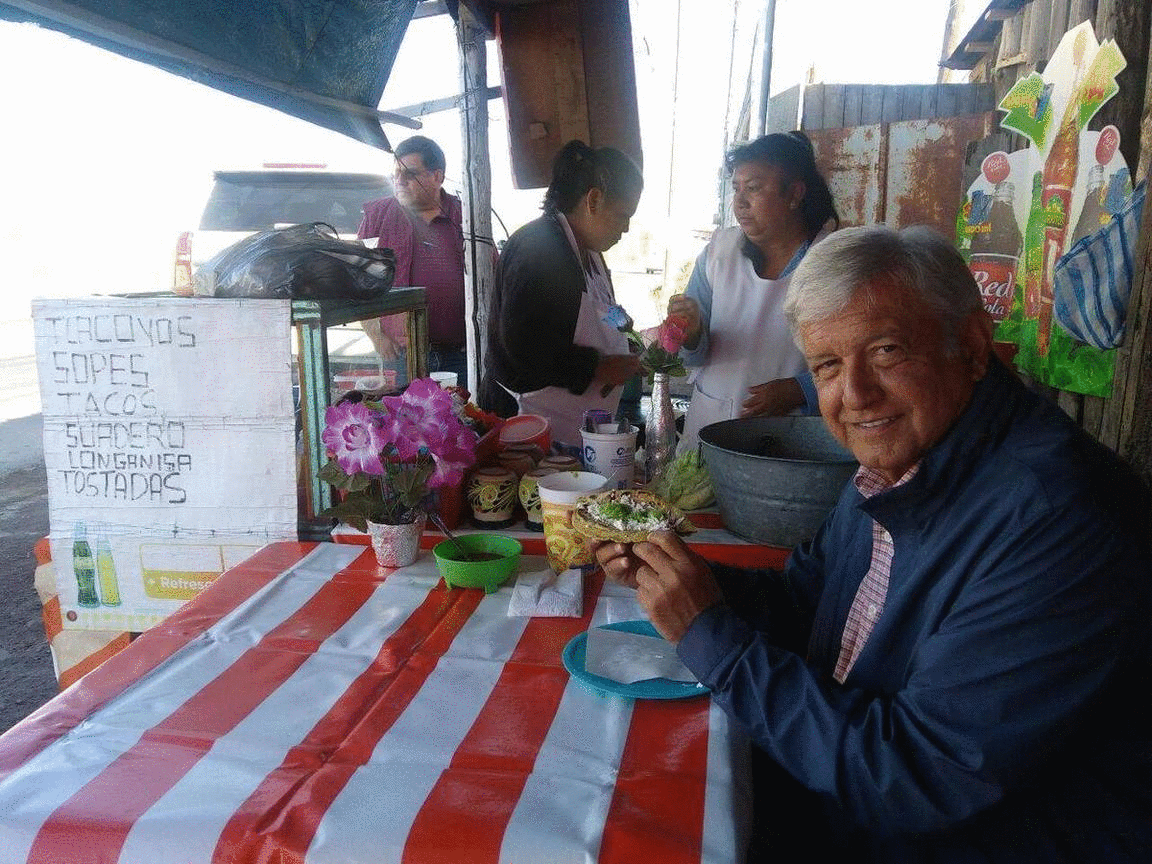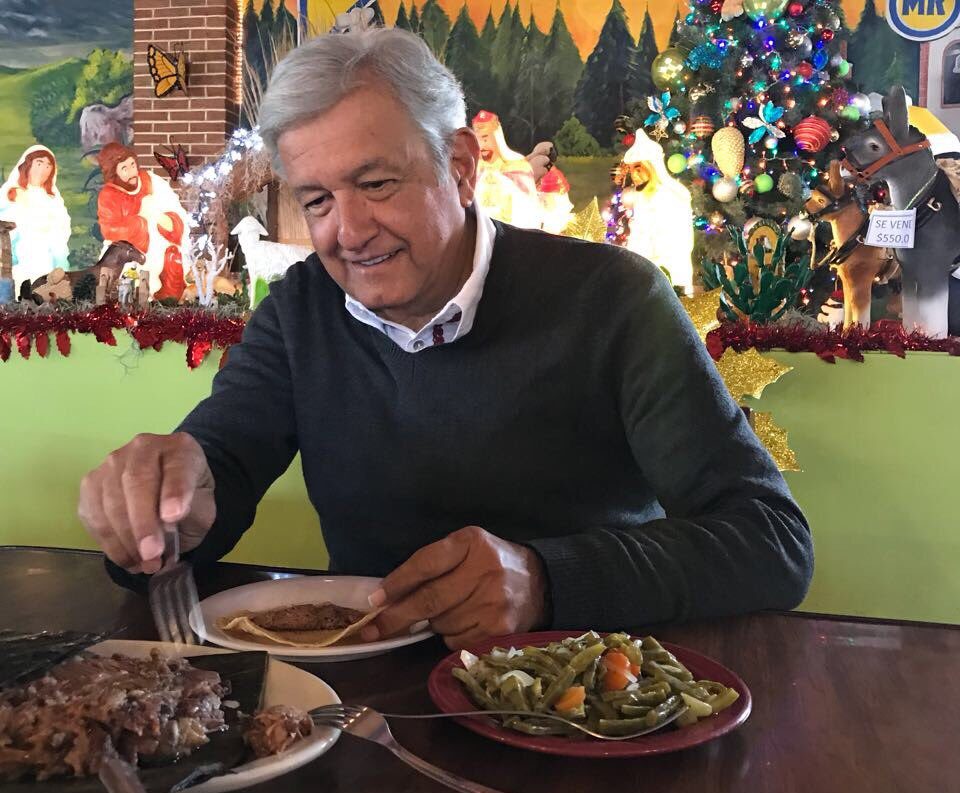
Food has always played a role in how we perceive politicians. An encyclopedic knowledge of regional cuisines may have swayed the recent Mexican presidential election.
In December of last year, as Mexico was gearing up to replace its much-loathed president, Enrique Peña Nieto, the three-time presidential candidate Andrés Manuel López Obrador, whose party, Morena, won a sweeping victory in last night’s elections, tweeted a brutal insult at his anticipated opponents from the bizarre right-left alliance known as Frente Ciudadano por Mexico, and the establishment PRI, which ruled Mexico from 1929 to 2000: “The posh candidates for ‘the power mafia,’” he wrote, “on top of not visiting villages to understand the feelings of the people, have missed out on eating the succulent barbacoa at ‘El Carnalito.’”
The tweet included an image of López Obrador, better known to his supporters as AMLO, pulling fat-slicked nobs of mutton from the charred surface of an agave leaf, a beneficent smile illuminating his handsome, grandfatherly face. To date, that tweet has garnered 9,902 likes, 3,454 retweets, and 2,105 replies. To know the people, he suggested, is to know their food. The people seemed to agree.
If rumors of Obama’s love of arugula during his first campaign gave him the unwanted reputation of an elitist, AMLO’s love of regional Mexican cooking has done the opposite.
In the 12 years since he started running for the presidency, AMLO has been photographed eating tamales, lechón, elotes, and gorditas while traveling between every last one of Mexico’s 2,464 municipal districts (he is famously the only candidate in Mexican political history to have visited them all). On May 26, he posted a picture of himself with a pile of blue-corn tortillas and yet another plate of barbacoa, along with the message, “I don’t want to hurt anyone’s feelings, but the barbacoa at ‘El Carnerito’ in Tulancingo, Hidalgo is strong competition for those in Palmilla and Texcoco.” AMLO’s barbacoa bracket became national news, appearing in the traditionally PRI-aligned paper Milenio with the lede: “Every Mexican is obsessed with ranking the places we’ve eaten….”
If rumors of Obama’s love of arugula during his first campaign gave him the unwanted reputation of an elitist, AMLO’s love of regional Mexican cooking has done the opposite. From the beginning of his political career nearly 40 years ago as a PRI official in his home state of Tabasco, AMLO has fashioned himself more effectively than any politician in recent history as a Man of the People, expanding pensions for senior citizens during his six-year stint as mayor of Mexico City, from 2000 to 2006, traveling the country with virtually nonexistent security, and frequently mocking his opponents for their elitism and disconnection from the Mexican people.
Food has also been a powerful part of his messaging, and his understanding of its political uses has been as nuanced as his policy plans are vague. An image of AMLO eating negritas (an inflated, deep-fried tortilla made from masa and black beans) with his campaign manager resonates powerfully with a population that’s tired of politicians literally dining out on state funds. Favoring simple Mexican dishes over the fancy versions served at high-end restaurants speaks to a growing nationalism–or mexicanismo, a word AMLO loves–justly riled by the vile rhetoric exploding out of the United States. He may not be able to explain how he’ll fund his ambitious social programs, but he can say (and will tweet, as he did on June 24) that the northern states of San Luis Potosí, Zacatecas, and Durango share the title for Mexico’s Best Gorditas.
His genuine love of Mexican cooking is so well known and so well documented that at the beginning of June, two self-described “AMLOvers” created a food guide based on his travels called “La Pejeguía del Buen Comer,” which combines one of AMLO’s nicknames (El Peje, derived from pejelagarto, an ancient fish native to Tabasco) with the word for guide, to mean something like “The AMLO Guide to Good Eats.” In a video on their Facebook page, the founders describe AMLO as “the only candidate who knows the food and the culture of the people.” As AMLO implied in his December tweet, that also makes him the only candidate who knows Mexico. Both things are indisputably true.
“Food has to do with culture,” he said in an interview with the guide’s founders, a statement that, emblematically, is both obviously true and basically meaningless. What he failed to say is that it also has to do with power.

Food symbolism may be more explicit in this election than in any that preceded it (social media is no friend to subtlety), but the connection between politicians and food is neither new or unique to Mexico. In the United States, we’ve transitioned over the last 150 years from a nation that favors big, prosperous men like Teddy Roosevelt and William Howard Taft–our national promise manifest in a great deal of flesh and blood–to one in which Donald Trump tweets a picture of himself with a limp-looking taco salad on 5 de Mayo to signify, clumsily, his cultural acuity.
Presidents are always symbols, as much as leaders, for their democracies. Capitalist democracies are built on consumption. What the president consumes, the democracy becomes.
For years now, Mexican presidential candidates have used food to telegraph a simple, and usually mendacious, story: that they’re connected to the people. Víctor Manuel Juárez, a Mexico City–based journalist who covered the campaign of disgraced former president Carlos Salinas de Gortari in 1988, told me that even then, in the decadent peak of the PRI’s hegemonic power, “part of the folklore of the campaign was to eat chiles en nogada in Puebla and mole in Oaxaca.”
“What they ate behind closed doors I couldn’t say,” Juárez went on with an insinuating chuckle, “but a Mexican candidate who doesn’t stop to eat a taco, he loses votes.” Post-election, Juárez says, state dinners would feature “gourmet” Mexican food, top officials would use state funds to pay for lunches at the capital’s finest restaurants, and lower-level bureaucrats would eat according to their pay grade–but always, at all levels, with a nose for quality (or at least for being seen).
During his years as Mexico City’s mayor under the banner of the left-wing PRD–a party now confusingly allied with the right-wing PAN, in opposition to the party that AMLO himself founded in 2012, called Morena–AMLO was known to eat mostly in his office. “Important politicians don’t go out to eat unless they want to send a very specific message,” said the journalist Katia d’Artigues in a 2005 interview for dF magazine. “Andrés Manuel López Obrador [goes out] very rarely.” When he did, she said, it was most often to dine with a select group of advisers at El Cardenal, a white-tablecloth classic in the historic center.
Whether AMLO still makes stops at El Cardenal I can’t say. He’s certainly not photographed there. Food is optics, and as Alonso Ruvalcaba, author of the recently published 24 Horas de Comida en la Ciudad de Mexico, told me recently, “no one does it better than AMLO.”
Like many successful politicians, and very much like the old guard of the PRI that formed him, AMLO’s great strength is his ability to expand, amoeba-like, to absorb anything and anyone. He’s promised to end corruption but won’t say how. He’s made political alliances with the old left and with the ultraconservative Encuentro Social, an evangelical group that opposes marriage equality and reproductive rights. He’s judged the best barbacoa in Mexico and held private breakfast meetings at El Cardenal. He’s chiles en nogada in Puebla and mole in Oaxaca and barbacoa in Hidalgo. For many people, all over Mexico, he’s also hope. That’s a tall order.